Essentially there are three main causes of laminitis.
Can acorns cause laminitis.
Laminitis is a complex cascade of events that causes the soft tissues laminae within the hoof to swell weaken and die.
The causes vary and may include the following.
Laminitis is quite unlike any other equine disease.
Tannin has a bitter taste and is an astringent contracts tissues and draws out fluids.
The bark leaves and acorns contain an acidic chemical commonly known as tannin.
Barbaro winner of the 2006 kentucky derby fractured his right hind and developed sll 2 months later.
In this article we will take a look at equine laminitis symptoms and treatment because a prompt recognition of horse laminitis and its treatment is essential to reduce the long term severity and improve the horse s overall health.
It is essential to determine the cause of laminitis so that we can provide the correct long term treatment strategies.
This can all occur before any symptoms are apparent and once the process has started it is extremely difficult to stop.
Two of the most common complications veterinarians face are injuries to the subsolar.
Laminitis is now regarded as a syndrome that occurs secondary to something else rather than a discreet disease all in itself.
Although laminitis occurs in the feet the underlying cause is often a disturbance elsewhere in the horse s body.
It can damage the liver and kidneys of horses.
While the exact mechanisms by which the feet are damaged remain a mystery certain precipitating events can produce laminitis.
There are more than 60 varieties of oaks in the continental united states.
Acorns are seeds or nuts produced by oak trees.
Further a thorough history can help the practitioner determine whether the laminitis likely developed due to systemic disease carbohydrate overload medications such as corticosteroids or.
When thinking of how laminitis occurs it is important to think of it more as a clinical sign rather than a disease in its own right.
Fortunately in the last 10 to 20 years there have been great strides in understanding the causes of this terrible condition.
Laminitis inflammation of the lamina of the hoof is a common and potentially devastating foot problem that affects all members of the equine family.
Horses ponies donkeys mules and wild equids the disease process involves a breakdown of the bond between the hoof wall and the distal phalanx commonly called the coffin bone pedal bone or third phalanx p3.
Laminitis itself is a precarious condition but complications can make cases even more challenging to manage.
Laminitis affects nearly 10 of the equine population and can occur with sudden onset in horses ponies and even donkeys.
Equine laminitis has been with us for a long long time.
A fracture or septic joint condition can cause laminitis in another leg usually the other leg in a pair.

